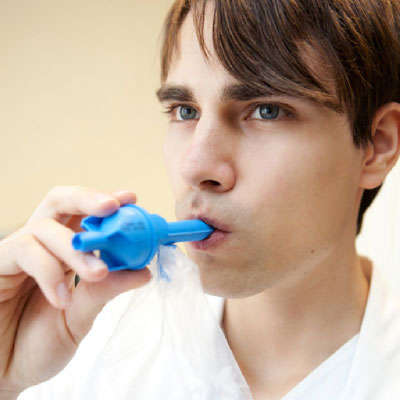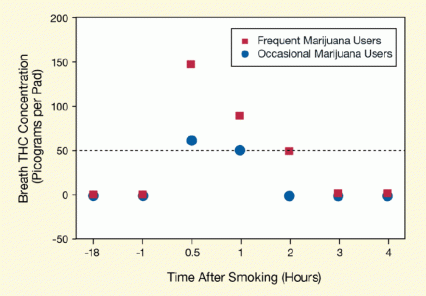 Figure 1. A Simple Breath-Collection Device Can Be Used To Screen for Marijuana Use A subject breathes into a SensAbues collection device, which contains a polymeric filter pad to capture marijuana metabolites, including THC. The metabolites are extracted from the pad and detected via mass spectrometry.
Figure 1. A Simple Breath-Collection Device Can Be Used To Screen for Marijuana Use A subject breathes into a SensAbues collection device, which contains a polymeric filter pad to capture marijuana metabolites, including THC. The metabolites are extracted from the pad and detected via mass spectrometry.Picture courtesy of http://sensabues.com
Breath expelled into a Breathalyzer-style collection device contained measurable amounts of marijuana’s main psychoactive ingredient, tetrahydrocannabinol (THC), for up to 2 hours after participants in a recent clinical trial smoked the drug. The finding by researchers at NIDA’s Intramural Research Program affirms that workplace and roadside breath testing for recent marijuana use is feasible in principle.
“Ours is the first basic research study using controlled administration of marijuana to determine if it is possible to detect metabolites in breath,” says study leader Sarah Himes, a doctoral candidate in toxicology and Intramural Research Training Award fellow at NIDA. Her positive result opens the way to further development of the marijuana breath-testing technique, which holds the potential to fulfill a public-safety need that has become increasingly pressing as marijuana use has risen and some jurisdictions have legalized use of the drug.
The Need for a Better Test
In a 2007 roadside survey conducted by the National Highway Traffic Safety Administration, 8.7 percent of weekend nighttime drivers tested positive for marijuana, 4 times as many as had blood alcohol concentrations exceeding the legal limit. “That was a wake-up call for the Nation,” says Dr. Marilyn Huestis, chief of the Chemistry and Drug Metabolism Section at NIDA and principal investigator on the study. “Marijuana negatively affects divided attention and executive function—brain functions that are needed for the complex behavior of driving,” she notes.
At present, authorities take people suspected of driving while impaired by marijuana or other drugs to a medical facility to have blood drawn and assayed. However, blood THC concentrations may be considerably lower by the time the blood is collected than when the person was behind the wheel. When fully developed, breath testing will avoid this problem: Authorities will be able to obtain breath samples, noninvasively as they do in alcohol testing, and interpret them on the spot.
Evidentiary Exhalation
Ms. Himes, working with Dr. Huestis and colleagues at NIDA’s Intramural Research Program (IRP), recruited 13 frequent and 11 occasional marijuana smokers for their study. The frequent users reported smoking the drug 4 or more times per week in the last 3 months, and the occasional users reported smoking less than twice weekly during that time. The researchers corroborated the participants’ self-reported use by measuring the concentrations of THC metabolites in their urine, saliva, and blood.
In the study, each participant smoked a single marijuana cigarette containing 6.8 percent THC, then provided breath samples at regular intervals using the SensAbues collection device (see Figure 1). The device, designed by study collaborator Dr. Olof Beck of Karolinska University Hospital in Stockholm, Sweden, traps cannabinoids on a polymeric filter pad. The IRP research team assayed the pads for THC using mass spectrometry.
 Figure 2. The Marijuana Metabolite THC Is Detectable in Exhaled Breath Frequent and occasional marijuana smokers submitted positive breath tests for THC at roughly 1 half-hour and 1 hour after smoking a single marijuana cigarette, on average, respectively. Frequent smokers also tested positive 2 hours after smoking. SensAbues breath pads detected the presence of THC on pads containing as little as 50 picograms of the metabolite (dashed line).
Figure 2. The Marijuana Metabolite THC Is Detectable in Exhaled Breath Frequent and occasional marijuana smokers submitted positive breath tests for THC at roughly 1 half-hour and 1 hour after smoking a single marijuana cigarette, on average, respectively. Frequent smokers also tested positive 2 hours after smoking. SensAbues breath pads detected the presence of THC on pads containing as little as 50 picograms of the metabolite (dashed line).
- Text description of Figure 2
-
The figure shows a time course of the concentrations of the marijuana compound tetrahydrocannabinol (THC) in the breath of marijuana smokers at different time points before and after smoking the drug and. The vertical (y)-axis shows the THC breath concentration (in picograms per SensAbues pad) and the horizontal (x)-axis the time before and after the study participants had smoked one marijuana cigarette. In the breath of regular smokers (red squares), THC concentrations 30 minutes after smoking rose to about 150 picograms per pad—well above the limit of detection (50 picogram per pad or more)—and THC could be detected for up to 2 hours in this group. In the occasional smokers (blue circles), breath THC concentrations rose to just above 50 picogram per pad and were detectable for only 1 hour.
The test results detected recent marijuana smoking in the initial breath samples from all the frequent users and all but one of the occasional users. The samples were obtained, on average, 0.9 hours after smoking. The percentage of breath samples testing positive for THC declined steadily in both groups as time passed, but did so more rapidly among the occasional smokers (see Figure 2). Among the frequent smokers, 77 percent of breath samples collected at 1.4 hours tested positive; 54 percent were positive at 2.4 hours; and zero at 3 hours. Among the occasional users, 64 percent were positive at 1.5 hours, and none at 2 hours. The frequent smokers’ median THC breath concentration was 94.8 picograms (pg) per pad, and the occasional users’ was 61.0 pg per pad.
The researchers also demonstrated that:
- Their mass spectrometry assay was highly sensitive, detecting THC on SensAbues pads containing as little as 50 picograms of the drug.
- THC was stable enough on the pads that reasonable delays in processing might not affect the usefulness of the results: When stored for 8 hours at room temperature, 72 hours at 4°C, or 6 months at −20°C, less than 20 percent of the drug was lost.
- THC measurements were unaffected by the presence of 92 other drugs that drivers might co-ingest with marijuana, including common stimulants, such as caffeine or nicotine; painkillers, such as aspirin or acetaminophen; and illegal drugs.
Steps to Road Readiness
The IRP study demonstrates that breath testing can reliably reveal recent marijuana smoking. The researchers’ focus now turns to making breath testing practical for use on the Nation’s roads.
“Our method allows a window of detection of only 1 to 2 hours after smoking,” Ms. Himes says. “There’s still a lot of work to be done to improve sensitivity and increase detection at later time points.” Ideally, a roadside-testing device should reliably yield positive results for as long as a smoker’s driving remains impaired, or for at least 6 hours.
Two additional hurdles must be surmounted before breath testing for marijuana can become a useful tool for highway safety: determining the concentrations of THC that correspond to driving impairment, and developing equipment that will permit on-the-spot analysis of breath-testing results.
In response to the first of these challenges, the IRP researchers are planning studies in which participants will take simulated driving tests after smoking marijuana. The results will guide lawmakers in setting reasonable legal limits for drivers’ THC breath concentrations.
An issue that will need to be addressed in setting such limits is the difference, seen in the current study, between frequent and occasional marijuana smokers’ breath THC concentrations. The reason for the difference, Dr. Huestis explains, is that the two groups smoke the drug differently: “People control how much drug they put in their bodies by the depth of inhalation, how quickly they puff, the time between puffs, and exhalation time.” Occasional users probably do not take in as much drug from the cigarette as frequent users do, Dr. Huestis says, nor do they have as much buildup of THC in their systems. However, occasional users, having less tolerance for the drugs’ effects, may be impaired at lower concentrations.
Although the SensAbues breath-collection device fits easily into a glove compartment or a coat pocket, the liquid chromatography-coupled tandem mass spectrometer that the IRP team used to assay the breath pads is a large machine found only in laboratories. Its lack of portability might not pose an obstacle for drug testing in workplaces and other situations where results are not needed on the spot and samples can be mailed away to be assayed. However, for use in identifying drugged drivers, both the collection device and the analysis equipment must be small enough to be kept ready at hand.
“This is just the start,” says Dr. Huestis. “We were able to achieve beautiful sensitivity using our sophisticated lab equipment. The next step will be to find instrumentation that can be used at the roadside.” Dr. Huestis believes this can be done, and points, as an example, to the equipment used in airports to check for explosives—which in fact are much smaller versions of the instruments used in the study.
The SensAbues device is being evaluated elsewhere for potential use in detecting drugs including cocaine, methamphetamine, heroin, and benzodiazepines.
Source:
Himes, S.K.; Scheidweiler, K.B.; Beck, O.; Gorelick, D.A.; Desrosiers, N.A.; Huestis, M.A. Cannabinoids in exhaled breath following controlled administration of smoked cannabis. Clinical Chemistry. 59(12):1780-1789. 2013. Abstract